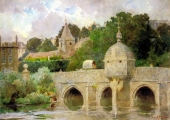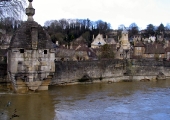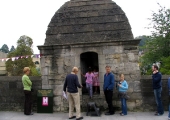.
Bradford on Avon Town Bridge
Bradford on Avon, Wiltshire
.
The Town Bridge at the beginning of the 19th century
.
The bridge over the River Avon is at the centre of the town and the focus of local roads. It is the icon of the town and has been chosen to figure in the logo of many local organisations, including that of Bradford on Avon Museum.
It replaced the broad ford over the river that gave the town its name, although the location of the original ford is not known with certainty. The ford may have had an antiquity that stretched back into the Ice Age, allowing migrating herds of reindeer, musk ox, woolly rhinoceros and mammoth to cross in the cold periods and elephant, aurochs, deer and bison in the warm spells. The ford would have been more obvious and useful, especially in summer, before the river was held back by Avoncliff weir.
A bridge here, perhaps made of wood, was mentioned in a deed of 1200 and again in the time of King Edward II (1307-27). It suffered some damage from floods in the 1340s and King Edward III decreed in 1350 that the “bailiffs and good townsmen of Bradeford” could take tolls on goods passing over it for five years to pay for repairs. Fifty years later in 1400 Pope Boniface IX appealed for funds for further repairs. In 1562 there was complaint that there was no coping (parapet). At this time the bridge was only 11 feet wide and it had to wait until 1769 to be widened to its present size; the junction between the old and new can be seen underneath.
The bridge at present has nine arches, of which the southern two are ribbed pointed gothic and date from the 13th or 14th centuries. On the upstream cutwater between these two arches is a small early 18th century building with a stone dome, which was the town’s two-cell lockup. At the top is a weather vane in the shape of a fish, which is known as the Bradford Gudgeon, although it does not really resemble a real gudgeon. An occupant of the cells was said to be “below the fish and above the water”, referring to the weather vane. John Aubrey, writing in 1660-1670, noted that it was then a chapel; medieval stonework was found during a restoration and the building belonged to the Abbey of Shaftesbury, passing down with the manor until the early 20th century. The antiquarian architect Sir Harold Brakspear carried out a restoration in 1927.






